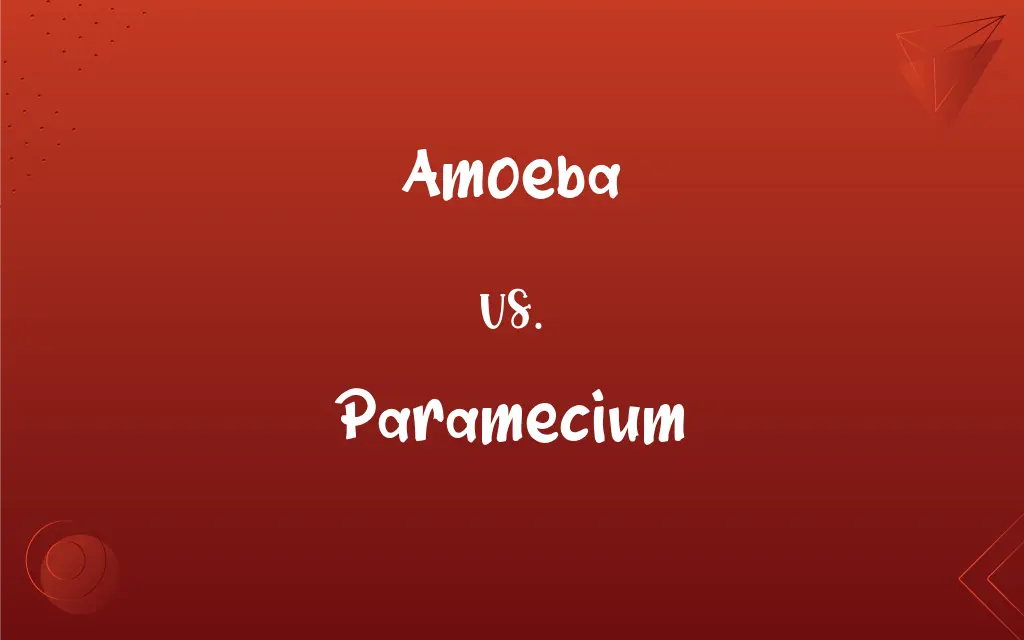Amoeba vs. Paramecium: What's the Difference?
Edited by Aimie Carlson || By Harlon Moss || Updated on July 5, 2024
Amoeba is a shape-shifting, single-celled organism using pseudopodia for movement, while paramecium is a ciliate with a fixed shape and cilia for locomotion.

Key Differences
Amoeba and paramecium are both single-celled organisms, but they belong to different groups. The amoeba is known for its amorphous shape and ability to change form, using extensions of its cell membrane called pseudopodia for movement and feeding. On the contrary, the paramecium has a consistent slipper-like shape and moves using hair-like structures called cilia, which cover its entire body.
In terms of feeding, the amoeba engulfs food particles through a process called phagocytosis, where its cell membrane encloses the food to form a food vacuole. The paramecium, however, has a specialized oral groove that directs food particles into its mouth, leading to a gullet where food vacuoles are formed.
Reproduction in amoebas typically occurs asexually through binary fission, where the cell divides into two identical cells. Paramecium also reproduces asexually by binary fission, but it can also engage in a form of sexual reproduction called conjugation, where two paramecia exchange genetic material.
Habitat-wise, amoebas are commonly found in freshwater, soil, and in some parasitic forms, inside host organisms. Paramecium is predominantly found in freshwater environments and is less adaptable to different habitats compared to amoebas.
In terms of adaptation, amoebas are known for their flexibility and adaptability, able to change shape and engulf various food particles. Paramecium, while less adaptable in shape, has complex organelles and structures like cilia and oral grooves that make it well-suited for its aquatic environment.
ADVERTISEMENT
Comparison Chart
Shape
Amorphous, shape-shifting
Fixed, slipper-like
Movement
Uses pseudopodia (false feet)
Uses cilia for locomotion
Feeding Mechanism
Engulfs food by phagocytosis
Has an oral groove and mouth for ingestion
Reproduction
Binary fission
Binary fission and Conjugation
Habitat
Freshwater, soil, some parasitic forms in hosts
Predominantly freshwater
ADVERTISEMENT
Amoeba and Paramecium Definitions
Amoeba
It’s a microscopic entity using pseudopodia for movement and feeding.
The amoeba moved across the field of view by extending and retracting its pseudopodia.
Paramecium
A paramecium is a ciliated, single-celled organism with a consistent shape.
The paramecium moved swiftly in the water due to the coordinated beating of its cilia.
Amoeba
This organism reproduces asexually through a process called binary fission.
Under favorable conditions, the amoeba divided into two daughter cells through binary fission.
Paramecium
Paramecium has specialized structures like an oral groove for feeding.
The paramecium used its oral groove to direct food particles towards its mouth.
Amoeba
Amoeba belongs to the kingdom Protista and thrives in various environments.
In the pond water sample, we observed an amoeba thriving among other microorganisms.
Paramecium
It’s known for its slipper-like shape and locomotion using cilia.
The paramecium’s cilia propelled it forward, creating a spiraling motion.
Amoeba
An amoeba is a single-celled organism known for its changing shape.
The amoeba in the microscope slide extended its pseudopodia to engulf a nearby food particle.
Paramecium
Paramecium belongs to the Ciliophora group and is common in freshwater.
In the freshwater aquarium, several paramecia were observed under the microscope.
Amoeba
Some amoebas are free-living, while others can be parasitic.
The parasitic amoeba caused an infection in the host’s intestinal tract.
Paramecium
This organism can reproduce sexually through conjugation and asexually by binary fission.
Two paramecia underwent conjugation, exchanging genetic material to enhance diversity.
Amoeba
Any of various one-celled free-living or parasitic protozoans having no definite form and moving by means of pseudopods.
Paramecium
Any of various slipper-shaped freshwater ciliate protozoans of the genus Paramecium, having an oral groove for feeding.
Paramecium
An oval-shaped protozoan organism of the genus Paramecium.
Paramecium
Any member of the genus Paramecium
FAQs
How does an amoeba move?
An amoeba moves by extending and retracting its pseudopodia.
What is an amoeba?
An amoeba is a single-celled, shape-shifting organism commonly found in water and soil.
What is a paramecium?
A paramecium is a single-celled organism with a fixed shape and cilia for movement, typically found in freshwater.
What are the main characteristics of a paramecium?
A paramecium is characterized by its slipper-like shape, cilia, and specialized feeding structures.
How do amoebas reproduce?
Amoebas typically reproduce asexually through binary fission.
Are paramecia used in educational settings?
Yes, paramecia are commonly used in biology classes for microscopic studies.
Can amoebas cause disease in aquatic organisms?
Some amoebas can be pathogenic to fish and other aquatic life.
What structures do paramecia use for movement?
Paramecia use hair-like structures called cilia for locomotion.
Can paramecia engage in sexual reproduction?
Yes, paramecia can reproduce sexually through a process called conjugation.
Are amoebas visible to the naked eye?
No, amoebas are microscopic and require a microscope to be seen.
What is the size range of amoebas?
Amoebas can range from a few micrometers to several millimeters in size.
How do paramecia respond to environmental changes?
Paramecia can respond to environmental changes through behaviors like avoiding predators or seeking food.
Do amoebas have a fixed shape?
No, amoebas are known for their amorphous, constantly changing shape.
Are there any beneficial roles of amoebas in ecosystems?
Yes, amoebas play a role in nutrient cycling and controlling bacterial populations in ecosystems.
What is the lifespan of a paramecium?
The lifespan of a paramecium can vary, typically ranging from a few days to a few weeks.
Can amoebas be harmful to humans?
Some amoebas can be parasitic and cause infections in humans.
Do paramecia have a specialized feeding mechanism?
Yes, paramecia have an oral groove and mouth for feeding.
Can amoebas survive in various environments?
Yes, amoebas can thrive in diverse environments including water, soil, and as parasites in hosts.
Do paramecia have any defense mechanisms?
Paramecia can use trichocysts, which are thread-like structures, as a defense mechanism.
What is the typical habitat for paramecia?
Paramecia are commonly found in freshwater environments.
About Author
Written by
Harlon MossHarlon is a seasoned quality moderator and accomplished content writer for Difference Wiki. An alumnus of the prestigious University of California, he earned his degree in Computer Science. Leveraging his academic background, Harlon brings a meticulous and informed perspective to his work, ensuring content accuracy and excellence.
Edited by
Aimie CarlsonAimie Carlson, holding a master's degree in English literature, is a fervent English language enthusiast. She lends her writing talents to Difference Wiki, a prominent website that specializes in comparisons, offering readers insightful analyses that both captivate and inform.
































































